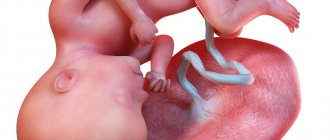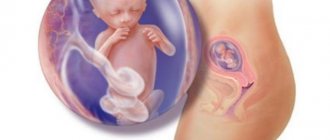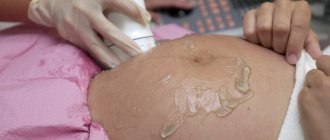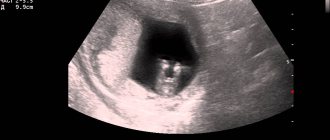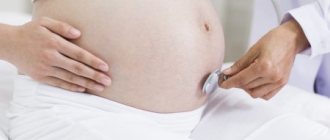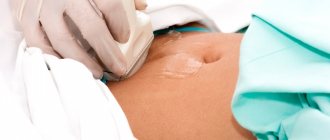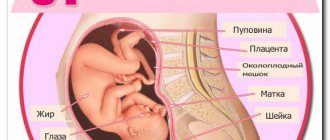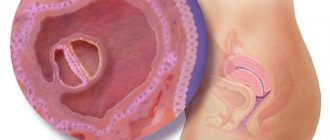The last trimester of pregnancy begins at 26 weeks. It is rightfully considered the most difficult for the expectant mother and at the same time very exciting. Ahead of the pregnant woman is a scheduled consultation with an obstetrician-gynecologist. She will also need to have an ultrasound at 26 weeks of pregnancy. At this time there will be another meeting with a small child.
The expectant mother needs to prepare for maternity leave. To do this, she will have to undergo many tests.
Condition of the uterus
The sonologist pays special attention to examining the condition of the uterus during an ultrasound examination. By the 7th month of pregnancy, this organ reaches impressive sizes:
- Width – 16 cm;
- Height 24 cm.
By this period, it is located 26 centimeters above the pubis (this is approximately 6 cm above the navel). In each subsequent week, the height of this organ will change by 1 cm. Increasing in size, it puts pressure on the organs of the expectant mother located inside the peritoneum. Because of this effect, a pregnant woman can experience bloating, heartburn, and constipation.
The cervical canal is filled with a mucus plug. At the time of birth, she must come out. At week 26, periodic contractions may appear. They are painless and irregular. This is a kind of preparation of the uterus for childbirth. You should call a doctor if you have pain or discharge during contractions.
At week 26, the amount of discharge may increase due to the formation of a mucus plug. With homogeneous light, whitish discharge, there is no need to worry. They are considered the norm. If the discharge is greenish and cheesy, it means that there is an infection in the body that needs to be cured.
Progress of intrauterine development of a child
The skin of a baby at 6 months is thin and slightly red, as will be visible on an ultrasound.
The child's cheeks are full, his eyes are already formed and are able to see what is happening around him. True, vision is not yet clear. He sees everything blurry, but he can already distinguish colors.
During this period, the child develops taste sensations. Therefore, he may or may not like the amniotic fluid he swallows.
It depends on what mom ate. The baby also senses its mother's mood, which is reflected by her heart rate.
At 26 weeks of intrauterine development, the baby is able to respond to sounds coming from outside and the voices of the parents.
Therefore, the expectant mother can already communicate with him, sing soothing lullabies and stroke her belly.
Video:
An ultrasound will show all changes in the child’s development. This procedure will show that his facial features have already been formed.
The nose still consists of fragile cartilage, the nails are soft until they grow to the tips of the fingers. During this period, the child’s ears move slightly to the sides, and a movable eyelid has already appeared on the eyes, which is why they can open and close.
During this period, the child’s respiratory system is finishing its formation, which will allow him to take his first breath immediately after birth.
The main respiratory organ takes on a triangular shape, the bronchial tree is directed with its apex upward.
At 26 weeks, the baby begins to produce the hormone responsible for growth.
The hormonal background as a whole is also formed, which occurs due to the establishment of connections between the cerebral cortex and the adrenal glands.
The reproductive system also develops rapidly; in boys, by this time the testicles drop.
READ Additional preventive measure - ultrasound of the cervix during pregnancy
Video:
At 6 months, the child’s musculoskeletal system begins to ossify. During this period, the teeth do not yet come out, but are embedded in the soft tissue of the jaws.
An ultrasound will allow you to listen to the baby's heartbeat. It should knock at least 120 times per minute.
Maximum heart rate – 160 beats. At 6 months, a baby’s skin is not yet smoothed out, which is why he resembles a wrinkled old man.
As soon as the fat layer under the skin is completely formed, the skin will smooth out and turn pink.
As the muscle system and subcutaneous fat layer are formed, the child’s weight also increases.
The ultrasound report will necessarily indicate how much the baby weighs and how it has grown. By this time, the child’s weight usually reaches a kilogram, and the length is more than 32 cm.
Photo:
Bipariental size (between the temporal bones) – BPR or BRGP; Thigh length – DlB; Chest diameter - DGrK
Changes in fetal development
Starting from the 26th week, when performing an ultrasound examination, the following changes are noted in the child’s body:
- The child's eyes are slightly open;
- The baby clearly detects the taste of the amniotic fluid surrounding him;
- Normally, almost complete formation of the inner ear is observed. From the 26th week, the baby is able to distinguish the pitch of sounds and recognize voices;
- At this time, the establishment of interaction between the adrenal glands and the pituitary gland of the brain is observed;
- Eyebrows and eyelashes are clearly visible on the face;
- The fat layer formed under the skin has almost completed its development.
What pregnancy complications can ultrasound help identify?
Ultrasound examination describes the condition of the placenta.
- Its thickness is measured. An increase in this indicator above normal may be due to Rh conflict or infection. The location of the lower edge of the placenta relative to the internal os is important. Normally, this distance is 6 cm and above. A decrease in this indicator indicates low placentation.
- When the lower edge of the placenta is located at the internal os or overlaps it, partial and central placenta previa occurs. These conditions are dangerous due to an increased risk of placental abruption and the development of life-threatening bleeding.
- Ultrasound is also used to determine the degree of maturity of the placenta. During pregnancy from 26 to 29 weeks it is normal. Detection of the first or second degree of maturity indicates a possible dysfunction of the placenta and requires Doppler ultrasound to assess uteroplacental blood flow.
- The number of vessels in the umbilical cord is described. Fixed if there is an entanglement of the umbilical cord. In case of a single umbilical cord artery or entanglement of the umbilical cord, additional Doppler measurements are performed.
- The amount of amniotic fluid is determined. Oligohydramnios may be a consequence of placental insufficiency or infection. Polyhydramnios can also occur due to infection and other reasons.
- Assess the condition of the cervix. Its length should be 3 cm or more. The internal os of the cervical canal must be closed. Shortening of the cervix and dilation of the cervical canal may be a consequence of isthmic-cervical insufficiency and require treatment in a hospital.
Purposes of ultrasound diagnostics
According to the rules, 3 scheduled ultrasounds are performed during the entire period of pregnancy. If a pregnant woman is at risk of developing certain pathologies, the doctor prescribes additional diagnostics. Also, the reason for performing an additional ultrasound examination is to clarify the date of the expected birth. Considering the peculiarity that from the very beginning of the third trimester, each child develops individually, the sonologist needs to very carefully examine the development of all organs of the fetus.
During ultrasound diagnostics, the specialist specifies the volume of amniotic fluid. Their quantity should be 700 grams. The quality of amniotic fluid is assessed; it should be less thick at this stage. This is due to the dilution of water with the child’s urine. The quality of amniotic fluid is affected by the nutrition of the expectant mother. Having determined the quality of the water, the doctor can make adjustments to the pregnant woman’s diet.
During an ultrasound, the sonologist pays special attention to the child’s lungs. By this time, they have practically completed their formation; they have distinct triangular contours, the apex of which is directed upward.
At week 26, the process of lowering the testicles into the scrotum continues. It must be completed by the time of birth. At this time, the child’s hormonal system works. The work of the pituitary gland (growth hormone) is observed. The heart is characterized by active work during this period. It performs 160 beats/minute.
By week 26, permanent teeth are formed in the gums. The baby is able to remember music. After childbirth, a certain reaction is observed when listening to music familiar to the child.
Researchers have proven that at this stage of development the baby is able to distinguish and respond to the tone of the mother's voice. He experiences the same emotions as his mother.
Purpose of ultrasound
An ultrasound examination at the 26th week of pregnancy allows you to determine the state of health of the child. The doctor must make sure that the size of the fetus fully corresponds to the physiological norm for this period. The presence of any deviations from external parameters is visually determined. Also, the ultrasound research method will help to identify the presence of defects of the cardiovascular and genitourinary systems or diseases that are genetic in nature.
Since the external genitalia have already been formed, future parents can find out not only about the state of fetal development by ultrasound, but also the gender of their child. During the examination, the condition of the placenta and how it is attached to the uterus are determined. Since amniotic fluid is the main environment for a child’s life, it is important to assess its quantity and quality.
Recommendations at 26 weeks of pregnancy
At 25-26 weeks of pregnancy, it’s time to start preparing for feeding: wash your breasts with cool water, take air baths, gently massage your nipples with a hard towel, but do not irritate them too much so that the uterus does not become toned.
A growing belly is making it difficult for you to sleep. For greater comfort, take small pillows with you to bed that you can place under your back, stomach, legs, or buy a special crescent-shaped pillow.
26 weeks of pregnancy is a period when rest is very important, but do not forget that movement is necessary for health. If there are no contraindications, walk, do gymnastics, but do not lift heavy objects. Now you need to be careful and beware of falling, because it can provoke placental abruption, premature rupture of amniotic fluid and the onset of labor. Don't overwork yourself, and if you feel weak, lie down immediately. Squatting pose helps with shortness of breath.
At 25–26 weeks of pregnancy, continue to monitor your weight. Try to control your appetite and eat only fresh, healthy foods for your baby.
Ultrasound standards for second screening
At 16-20 weeks, a second screening is done. In addition to the size, the doctor looks at how the fetus is positioned and the condition of the fetal organs.
Ultrasound standards look like this:
- BPR - 26–56 mm.
- The length of the femur bone is 13–38 mm.
- The length of the humerus bone is 13–36 mm.
- Exhaust gas - 112–186 mm
- Water levels are 73–230 mm. If oligohydramnios is detected, this negatively affects the formation of the baby’s nervous system.
In addition to the above, the doctor looks at the location of the placenta. If it is located on the anterior wall of the uterus, then there is a risk of detachment.
Another important indicator that the doctor pays attention to is the location of the umbilical cord attachment.
What happens at this time
Your baby continues to grow, your belly gets bigger, and you may feel short of breath and sometimes want to take a really deep breath. The stomach is already shifting the center of gravity, and your gait may change. At this stage of pregnancy, the mother’s weight may already be nine kilograms higher than her pre-pregnancy weight. Pay maximum attention to proper nutrition, because the optimal weight of mother and baby plays an important role in the normal course of childbirth.
Due to the tension of the skin on your abdomen, you may sometimes feel itching and a slight burning sensation. Use special creams for stretch marks - this way you will cope with unpleasant sensations and can prevent or significantly reduce the appearance of stretch marks. Be sure to wear a bandage: this way you can reduce the pressure of the uterus on the bladder, reduce stress and back pain.
Typically, after the thirtieth week of pregnancy, antenatal courses begin, and it’s time to sign up for them. At such courses you will receive a lot of useful tips and interesting information about the birth of a baby and the first days of motherhood. Even if you think that you already know everything about childbirth, sign up for courses, or better yet, together with your partner. After such courses, the spouses develop stable confidence, calmness, and an attitude towards the best outcome.

